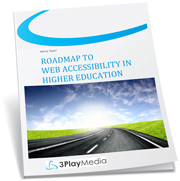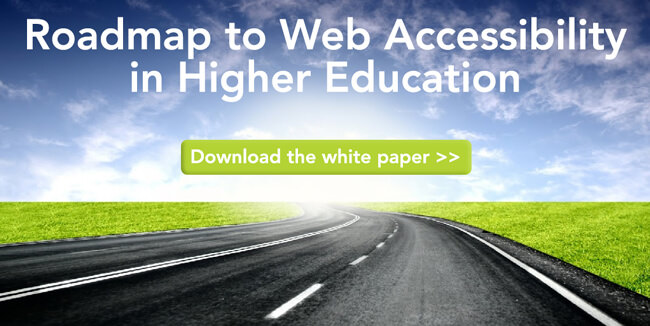3 “Dear Colleague” Letters You Should Read About Inaccessible IT in Higher Ed
Updated: March 2, 2021
Because the ADA and Section 504, which were written before the Internet was a part of everyday life, don’t provide specific requirements for online learning, much of the responsibility for making IT accessible has been extrapolated from court rulings, lawsuits, settlements, and Department of Justice (DOJ)/Department of Education’s Office for Civil Rights (OCR) inquiries.
In addition to dozens of inquiries, complaints, and investigations into inaccessible IT in higher education over the last several years, the DOJ and OCR have submitted “Dear Colleague” letters on the subject to numerous colleges and universities.
While “Dear Colleague” letters don’t set legal precedents, they do help to inform the industry of the DOJ and OCR’s stance on major issues, as well as the standards, requirements, and solutions that they believe educational institutions should be following with regards to web accessibility.
The following three letters document particularly interesting trends in the OCR’s position on web accessibility in higher education.
University of Cincinnati
In December of 2014, the OCR submitted a “Dear Colleague” letter to the University of Cincinnati addressing the university’s web accessibility. The letter notes the conclusions of a compliance review initiated by the OCR in 2013; there was no litigation.
This letter is interesting for two reasons: first, it humanizes the legal standards by giving concrete examples of how inaccessible IT affects students with disabilities; and second, it identifies the breadth of online services that the OCR will cover.
Key Takeaways
1: The OCR wants colleges and universities to understand the impact of failing to accommodate individuals with disabilities.
2: This letter demonstrates the broad range of university activities that the OCR considers in an IT accessibility investigation.
3: The University of Cincinnati’s response sets a great example of how colleges should respond to a compliance review and build a sustainable architecture for web accessibility at the institutional level.
In the letter, the OCR clearly defined the technical deficiencies they found and mapped them to the human experience. For example, after noting a “lack of captions on all videos and the inability to operate video controls using assistive technology,” they describe what that means to someone who is deaf:
The letter covers a broad range of university activities, including personnel, the disability services office, Blackboard, the distance learning program, and the University’s webpages related to admissions, financial aid, disability services, e-learning, library services, athletics, graduate programs, housing, and registration. This demonstrates the breadth of technology, policies, and personnel that the OCR considers in a compliance review.
Since this letter was submitted, the University of Cincinnati has taken a progressive approach to web accessibility. In addition to focusing on the specific compliance issues noted in the letter, they have instead worked to shift the culture around accessibility on campus. They have taken this as an opportunity to remediate existing issues and to systematically change the approach to accessibility at the institutional level.
For the University of Cincinnati, sustaining a high level of accessibility across campus means developing best practices, bringing new staff on board, getting executive sponsorship, and making sure purchases and licensed software are accessible. By building awareness and proactive processes for accessibility, the University of Cincinnati is developing a sustainable architecture for web accessibility at the institutional level. This is exactly what the OCR looks for in response to a compliance review.
University of Phoenix
In June of 2015, the OCR submitted a letter to the University of Phoenix in response to an investigation that originated from a student complaint that the University “discriminated against her and others on the basis of a disability when it switched to a new online learning platform.”
This letter is important because, in the attached resolution agreement, it lays out Web Content Accessibility Guideline (WCAG) 2.0 standards. While WCAG 2.0 is considered the international standard for web accessibility, its guidelines are not referenced in any US federal accessibility laws.
In the letter, the OCR states that “the accessibility of online content and functionality will be measured, initially, according to the following accessible technology standards,” referencing WCAG 2.0 Level AA.
Key Takeaways
1: The OCR thinks WCAG 2.0 Level AA standards should be followed to ensure web accessibility.
2: The OCR believes that students who experienced discrimination in the past due to the inaccessible IT discovered in the investigation should be eligible for “particular forms of relief.”
This suggests that the OCR believes WCAG 2.0 Level AA standards should be followed by colleges and universities to ensure their web content is accessible.
The other interesting thing to come out of this resolution agreement is that it identifies the retroactive damage that may have been incurred by the University’s failure to accommodate students with disabilities in the past. The letter defines remedies for students who may have been impacted by inaccessible IT in the last 24 months. This indicates that the OCR believes that all students impacted by their findings, not just the student who submitted the complaint, should be eligible for relief.
Michigan Department of Education
In June of 2015, the OCR submitted a letter to the Michigan Department of Education (MDE) in response to a complaint in 2014 that their website was inaccessible to persons with disabilities.
Again, this letter is interesting for two reasons. First, it discusses in detail the requirements for online video accessibility in the attached resolution agreement – an accommodation which is not referenced in the ADA or in Section 504 at all, although it has been applied to both laws in investigations, complaints, and lawsuits.
Specifically, they state:
Key Takeaways
1: The OCR has formulated an opinion about online video accessibility, regardless of its specific inclusion in the ADA and Section 504.
2: The OCR considers inaccessible IT a violation of Section 504 and the ADA.
Another important note about this letter has to do with word choice. In this letter, the OCR specifically states that the MDE was found in violation of Section 504 and the ADA for failing to make their web content accessible. Calling their findings “violations” presumes that even though the law does not currently specify IT accessibility, the OCR interprets it as a requirement.
Dear Colleague Letters to College & University Presidents
Important reading for all colleges and universities are two Dear Colleague letters sent jointly by the DOJ and OCR that put the issue of web accessibility in higher education on the map. The 2010 Dear Colleague letter was sent from the DOJ & OCR to all college and university presidents and highlights how the ADA & Section 504 apply to educational technology.
In 2011, they sent a second Dear Colleague letter and attached FAQ to further clarify the responsibilities dictated in their 2010 letter.
—
This article was updated on August 23, 2017 to reflect the University of Cincinnati’s response to the letter received, as well as their ongoing accessibility efforts.







